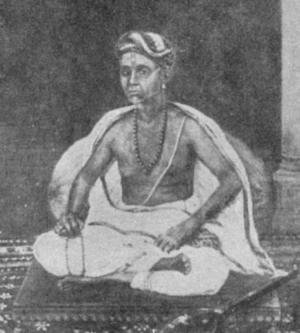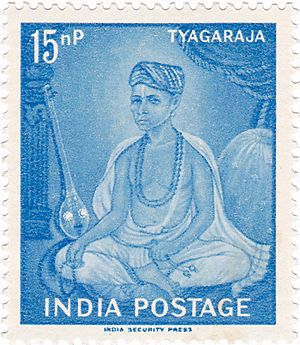Tyagaraja facts for kids
Tyagaraja (born May 4, 1767 – died January 6, 1847), also known as Tyāgayya, was a very famous composer of Carnatic music. This is a special type of Indian classical music. He was a very important person in the history of India's classical music.
Tyagaraja, along with Shyama Shastri and Muthuswami Dikshitar, are known as the "Trinity of Carnatic music". He wrote thousands of devotional songs, mostly in Telugu. These songs praised Lord Rama, and many are still popular today. Five of his most famous songs are called the Pancharatna Kritis, which means "five gems". These are often sung at events honoring him.
Tyagaraja lived during the rule of four kings from the Thanjavur Maratha kingdom. However, he never worked for any of them.
Quick facts for kids
Tyāgarāja
|
|
|---|---|

A painting of Tyagaraja from the Jaganmohan palace in Mysore
|
|
| Born |
Kakarla Tyagabrahmam
4 May 1767 |
| Died | 6 January 1847 (aged 79) Thiruvaiyaru, Thanjavur Maratha kingdom
|
| Occupation | Carnatic composer |
Contents
Tyagaraja's Early Life and Family
Tyagaraja was born as Kakarla Tyagabrahmam in 1767. His family was a Telugu-speaking Mulukanadu Brahmin family. They lived in Thiruvarur in what is now Tamil Nadu. Some people believe he was born in Tiruvaiyaru instead.
His family name, 'Kakarla', suggests they originally came from a village of the same name. This village is in the Prakasam district of Andhra Pradesh. Tyagaraja was the third son in his family. He was named after Tyagaraja, the main god of the temple in Thiruvarur.
Tyagaraja's grandfather, Giriraja Kavi, was a poet and musician. His maternal grandfather, Kalahastayya, was a well-known veena player. Tyagaraja learned to play the veena from him when he was a child.
After Kalahastayya passed away, Tyagaraja found a music book called Naradeeyam. Tyagaraja greatly admired the wise sage Narada. It is said that a holy man taught him a special chant for Narada. After meditating, Tyagaraja had a vision of Narada and received a book called Svarārnavam.
In his later years, Tyagaraja became a Sannyasa, which means he gave up worldly things. He passed away on January 6, 1847, at 79 years old. His last song was Giripai Nelakonna. He was buried by the Kaveri river in Thiruvaiyaru.
Tyagaraja's Musical Journey
Tyagaraja started learning music at a young age. His teacher was Sonti Venkata Ramanayya, a music expert. Ramanayya was very impressed by Tyagaraja's talent as a child prodigy.
Tyagaraja believed that music was a way to feel God's love. His songs focused on expressing feelings rather than just showing off musical skills. As a teenager, he wrote his first song, "Namo Namo Raghavayya". He wrote it on the walls of his house.
His songs are mostly about devotion or deep thoughts. In his songs, he often talks to his favorite god, Lord Rama. He also shares stories or messages with people. He wrote songs praising other gods like Krishna, Shiva, and Ganesha too.
Turning Down the King
Sonti Venkataramanayya told the king of Thanjavur about Tyagaraja's amazing talent. The king invited Tyagaraja to his royal court and sent him many rich gifts. However, Tyagaraja did not want to work for the king. He turned down the invitation right away.
It is said that he wrote the song Nidhi Chala Sukhama (meaning "Does wealth bring happiness?") at this time. This song showed that he valued his devotion more than money or fame.
Tyagaraja spent most of his life in Tiruvaiyaru. He also traveled to holy places like Tirumala and Kanchipuram.
Preserving His Music
Tyagaraja was very devoted to Rama and lived a simple life. He did not keep a careful record of all his many songs. Many of his wonderful musical works were lost over time.
Usually, Tyagaraja would sing his songs while sitting in front of statues of Lord Rama. His students would write down the details of his songs on palm leaves. After he died, these palm leaves were passed down through his students' families. There was no single, complete collection of his songs.
His songs in Telugu became very popular because they were easy to sing. Music experts like Kancheepuram Nayana Pillai and Veenai Dhanammal saw how much musical creativity was in his songs. They carefully wrote down the music for the songs they had.
Later, researchers like K. V. Srinivasa Iyengar and Rangaramanuja Iyengar worked hard to find teachers and families who had the palm leaves. They published large collections of Tyagaraja's songs. Other scholars also published his songs with their meanings.
It is believed that Tyagaraja composed about 24,000 songs. However, only about 700 of them remain today. Experts are not sure if he really wrote that many songs.
Musical Plays and Legacy
Besides his nearly 700 songs, Tyagaraja also wrote two musical plays in Telugu. These are Prahalada Bhakti Vijayam and Nauka Charitam.
Prahlada Bhakti Vijayam has five acts with 45 songs and 138 verses. Nauka Charitam is a shorter play with 21 songs and 43 verses. Nauka Charitam is his most popular play. It was created from Tyagaraja's own imagination and is not based on old stories. He also wrote simple devotional songs for groups to sing.
A music critic named K. V. Ramachandran said that Tyagaraja was special because he not only shared old music but also created new musical ideas. He used new words and new music to praise his god, Rama. This made him different from other famous musicians of his time.
Remembering Tyagaraja
The Tyagaraja Aradhana is a music festival held every year in Thiruvaiyaru, Thanjavur district, Tamil Nadu. It happens in January or February to honor Tyagaraja. This festival lasts a week. Carnatic musicians from all over the world come together at his resting place.
On a special day called Pushya Bahula Panchami, thousands of people and hundreds of Carnatic musicians sing the five Pancharatna Kritis together. They are joined by many instruments like veenas, violins, flutes, nadasvarams, mridangams, and ghatams.
A sports complex in New Delhi, called Thyagaraj Sports Complex, is named after him. Also, a crater on the planet Mercury was named after Tyagaraja in 1976.
Tyagaraja's Famous Compositions
The term Pancharatna means "five gems" in Sanskrit. These five songs are considered the finest gems of Carnatic music. All of them are set to a rhythm called Adi Talam. Musicians have passed down these songs very carefully over the years.
Tyagaraja's songs show how to develop different ragas (musical scales) in a systematic way. But in the Pancharatnas, he showed the most complete way to develop a raga. These songs follow strong rules of harmony and flow. They are also composed with perfect sarvalaghu swaras, which means the notes fit together naturally.
- The first Pancharatna is Jagadaanandakaaraka. It is in the raga Nata and is written in beautiful Sanskrit. It praises Lord Rama as the source of all happiness in the universe. This song originally had six sections. When his students looked at it, they found 90 names of Lord Rama. They asked Tyagaraja to add two more sections with 18 more names. He agreed, which is why this song has three "mudras" (places where Tyagaraja's name is mentioned), while the others have only one.
- The second is Duduku gala. It is in the raga Gowla and is in Telugu. In this song, Tyagaraja takes the blame for all the wrong things people do. He wonders who will come to save him from this sad situation.
- The third is Saadhinchene. It is in the raga Aarabhi and is in Telugu. In this song, Tyagaraja playfully criticizes Lord Krishna. He talks about how clever Krishna is at getting what he wants. Saadhinchene is a beautiful, calming song.
- The fourth song, Kana Kana Ruchiraa, is in the raga Varaali and is in Telugu. In this song, Tyagaraja describes the endless beauty of Lord Rama.
- The fifth Pancharatna is Endaro Mahaanubhaavulu. It is in Sri Raaga and is in Telugu. It is said that a great musician from Kerala, Shatkala Govinda Maaraar, visited Tyagaraja and performed for him. Tyagaraja was so impressed that he then composed Endaro Mahanubhavulu. This song has amazing rhythm in Carnatic music.
Other important songs by Tyagaraja include Saamajavaragamana (in Hindolam raagam) and Nagumomu kanaleni (in Aabheri raagam).
See also
 In Spanish: Tyagaraja para niños
In Spanish: Tyagaraja para niños


